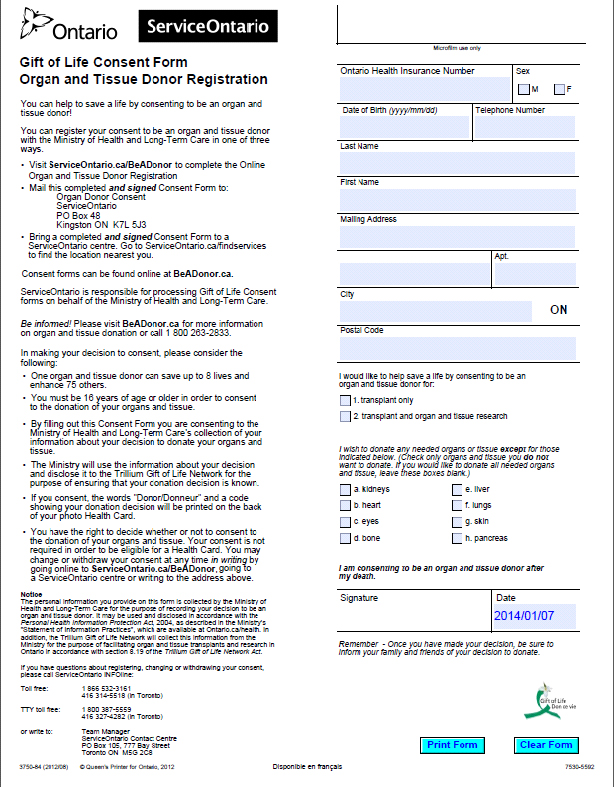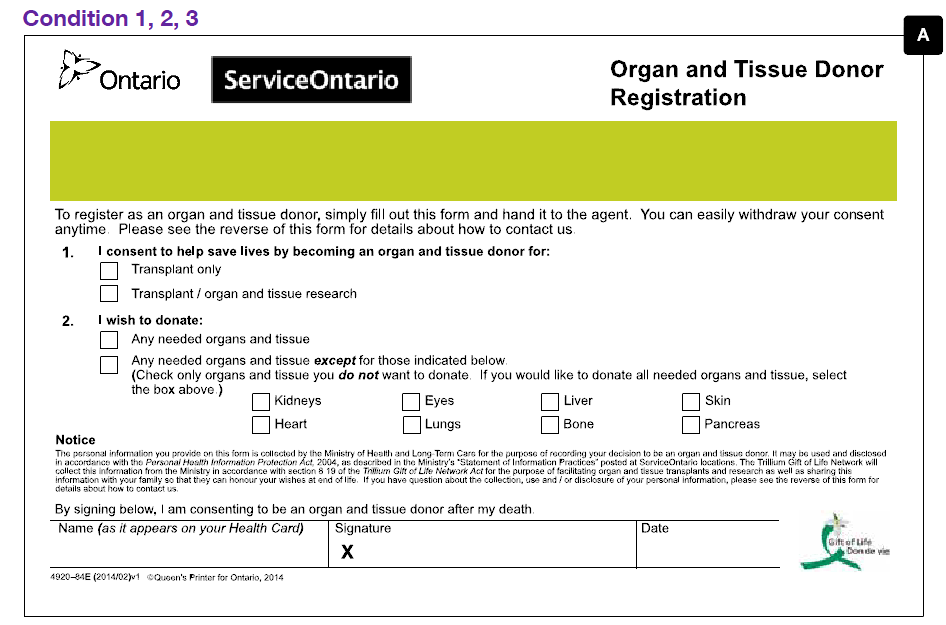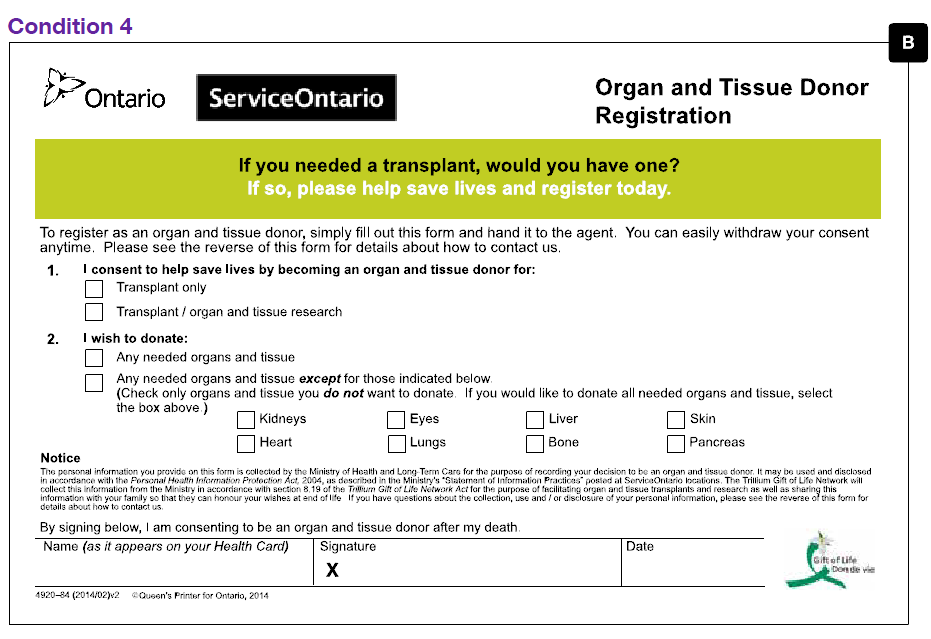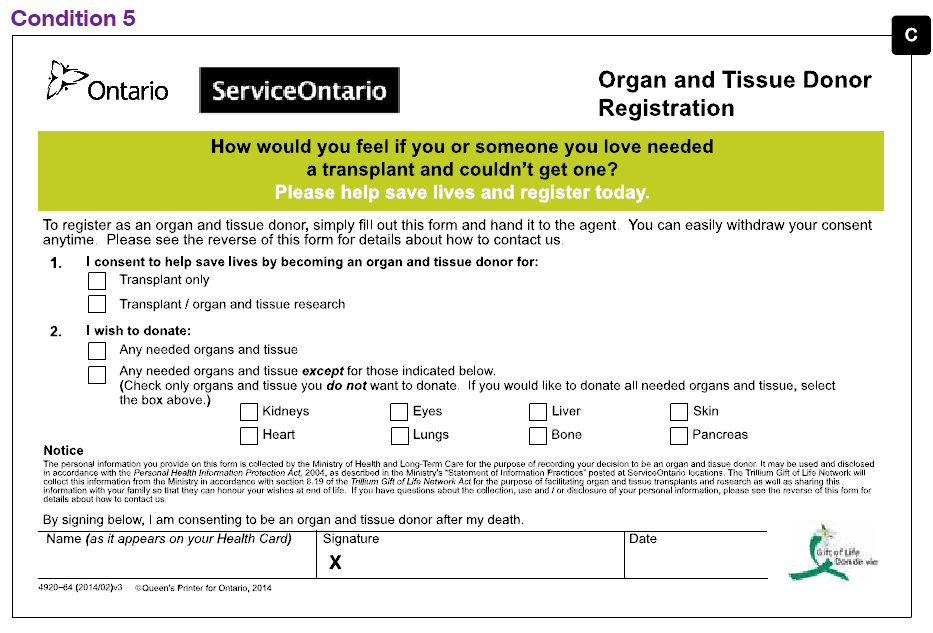Behavioural Insights Pilot Project – Organ Donor Registration
Information and findings from a behavioural science insights pilot project conducted by Ontario Ministry of Health and Long Term Care, Trillium Gift of Life Network, the Ministry of Government and Consumer Services and Treasury Board Secretariat’s Behavioural Insights Unit, in collaboration with the Behavioural Economics in Action at Rotman Centre (BEAR), to improve the organ donor registration process and increase registration rates.
Executive summary
In Ontario, more than 1,500 people are currently waiting to receive life-saving organ transplants.
We know the majority of people across the province are willing to register as an organ and tissue donor. Yet only 25% of Ontarians are registered. The Greater Toronto Area has one of the lowest registration rates in the province, with only 16%.
Behavioural insights is a tool that provides a unique opportunity to increase organ and tissue donor registration rates in Ontario. This tool can help influence people’s behaviour and create positive change using the principles of behavioural economics, psychology and social marketing.
Through randomized control trials, behavioural insight practitioners test the impact and effectiveness of policy changes on people’s behaviour. The most effective interventions can then be more broadly applied to make the biggest impact on policies and programs.
The Ministry of Government Services’ Behavioural Insights Unit is exploring the use of this tool across government. In Spring 2014, the team partnered with Rotman’s Behavioral Economics in Action Research Cluster, Trillium Gift of Life Network, ServiceOntario and the Ministry of Health and Long-Term Care to pilot the use of behavioural insights in organ donor registration.
Together, we set out to improve the organ donor registration process and increase registration rates. We ran an eight-week trial at one ServiceOntario centre. Currently, 85% of donor registrations take place at ServiceOntario centres.
There, we tested a number of interventions on the donor registration process based on the principles of behavioural insights. This included:
- providing different versions of the organ donor registration form
- changing the timing of when the form was handed out
- offering additional donor information to help people make their decision.
We also simplified the registration process, making it easier and faster to complete organ donor transactions for both the public and customer service representatives.
The pilot project was a great success, significantly increasing organ donor registration rates. Registration rates increased up to 143% compared to current registration rates at the location.
If we were to implement these successful changes, we could garner over 450,000 new registrations in Ontario annually, approximately 200,000 more than the status quo.
Three of our conditions outperformed all others. These conditions applied behavioural insights interventions including nudge statements, and adding an information brochure to a simplified form.
This paper provides an overview of the project, including our method and results. It also highlights the benefits of applying the principles of behavioural insights to deliver effective and efficient policies and programs.
Introduction
Organ donation in Ontario
Ontario uses a prompted-choice system to register organ and tissue donors. That means Ontarians are asked whether they want to register as a donor during health card, driver’s licence and photo card transactions at ServiceOntario centres. People can also proactively register online at BeADonor.ca.
In the past year, 232,628 Ontarians registered to become organ and tissue donors, bringing the total number to 2.9 million out of an eligible 11.7 million.
This means that only 25% of eligible donors have registered. Our registration rate remains significantly lower than other jurisdictions that use a prompted choice system, where registration rates hover at about 50%.
Because research shows a broad willingness among Ontarians to register, we wanted to test whether behavioural insights could help close the gap. Our pilot project began with developing a better understanding of how people register as donors and identifying what might prevent them from doing so.
Understanding the process
Currently, 85% of organ donor registrations in Ontario occur at a ServiceOntario centre – in person or by mail. So we focused our research and efforts on the in-person process.
We worked with ServiceOntario to understand how people register as donors.
When people visit a ServiceOntario centre for health card, driver’s licence and photo card transactions, they are prompted to register as an organ donor by being asked by the customer service representative:
"Would you like to register your decision today to donate organs and tissues to help those in need of transplants?"
If an individual agrees, they are given a lengthy registration form to complete on the spot. The information is then entered into the computer by the customer service representative while the individual waits. See page 4 for the original form.
Identifying the barriers
Based on existing research from the Trillium Gift of Life Network, we identified a number of barriers that could prevent individuals from registering as donors:
- the public seems unprepared for the donor registration question when prompted at the service counter
- the organ donor registration form is complex and therefore time consuming for both the customer service representatives as well as for individuals
- once individuals agree to register and are given the form, they often change their minds after seeing the form because of its complexity
- because of the lengthy process and high-volume customer traffic, customer service representatives do not always prompt individuals.

The pilot
Developing the game plan
After careful analysis of the donor registration program and research, we designed a pilot project based on the established principles of behavioural insights. Our goal was to find ways to improve the in-person organ donor registration process and increase registration rates.
Based on the theories of behavioural insights, the team used four types of interventions:
- simplification: a simplified version of the current donor registration form
- timing: handing the form out sooner, at the reception desk, rather than at the service counter
- nudge: one of three nudge statements added to the top of the simplified form
- information: handing out the current Trillium Gift of Life Network brochure, rather than not handing out anything
Bringing the pilot to life
Working with ServiceOntario, we identified the best centre to conduct our pilot project – one that has a representative and sizable population, along with a reception desk. We decided on a large public centre in the Greater Toronto Area to test our interventions and determine how they impact registration rates. The location of our pilot is one of 10 large ServiceOntario centres in the province. These centres have a reception desk where a staff person hands out a queuing number to indicate their place in line.
Our pilot ran for eight weeks from Mondays to Saturdays:
- two weeks using the original form and process (our control)
- four weeks testing the interventions
- two weeks of post-experiment control data.
Over 10,000 people took part in our eight-week trial. We collected data in partnership with ServiceOntario using their computer system.
Within our four interventions, we tested six different conditions. This allowed us to compare the registration rates of these conditions to our control, to see which conditions and interventions have the biggest impact.
Testing the conditions
The experiment began with two weeks of control. For the control weeks, individuals went through the standard organ donor registration process — receiving the original form at the counter from the customer service representative.
Condition 1 introduced a simplified version of the registration form (Form A).
Research shows that the easier it is to do something, the more likely we are to do it.




In Condition 1, we wanted to examine whether any of the changes observed during the pilot (e.g. increased registration rates) might be explained by the fact that a pilot was being run. That’s because piloting something new may lead to a change in the typical behaviour of customer service representatives. For this reason we tested two versions of Condition I – 1.1 and 1.2. The only difference between the versions was timing and the messaging delivered to staff.
In version 1.1, customer service representatives were notified that an organ donor registration pilot project was about to be run, with new forms and procedures. Customer service representatives were asked to complete the organ donor transactions as they had been doing before.
In version 1.2, we notified customer service representatives that it was the last week of the pilot and we would continue tracking registration rates for one final week. This was the first time we explicitly mentioned that we were tracking rates.
By comparing these two versions of Condition 1, we can assess whether the messages to staff had any impact on registration rates.
Condition 2 introduced the effect of timing.
We handed out the simplified form (Form A) at the reception desk when individuals received their queuing number, as compared to handing out the form at the service counter.
One of the barriers we identified in our research was that individuals are often unprepared for the organ donor registration question. By presenting the form in advance, we gave the individual time to consider their decision and fill out the form while they waited for service. In addition, by handing out the form at the registration desk we aimed to streamline the registration process and reduce the transaction time.
Condition 2 also served as a baseline for the remaining conditions. It allowed us to compare the effectiveness of simplification alone against the addition of information and nudge statements.
Condition 3 tested the effect of providing more information.
We handed out a brochure at the reception desk along with the simplified form (Form A).
We hypothesized that some individuals may not have enough information to make an informed decision. By handing out the current Trillium Gift of Life Network brochure, we gave individuals additional information to help them make a decision.

Conditions 4, 5 and 6 tested the behavioural insights principle of motivating action by adding a nudge statement.
Previous research has found that even small changes in messaging can have a significant impact on individuals’ decisions and behaviours.
We tested three versions of the simplified registration form with different nudge statements at the top. By keeping everything else the same (simplification and timing), we were able to test the effectiveness of each nudge statement.
Condition 4 tested the behavioural insights’ principles of reciprocity and fairness.
We leveraged pilot research conducted in the UK,
"If you needed a transplant, would you have one? If yes, please help save lives and register today."
Condition 4 used the UK’s successful nudge statement on the simplified form (Form B). By reminding people that they would accept an organ transplant if they needed one, they are encouraged to behave fairly and reciprocate by registering to become a donor.
Condition 5 tested the behavioural insights principles of affect and personal relevance.
Condition 5 sought to motivate action by drawing on people’s emotions (Form C):
"How would you feel if you or your loved one needed a transplant and couldn’t get one? Please help saves lives and register today."
This nudge reminded people that, without enough registered donors, an organ or tissue transplant might not be available to someone in need. This statement also made people aware of how negatively that may feel. Research has demonstrated the effectiveness of appealing to peoples’ negative emotions.
Condition 6 tested the behavioural insights principles of affect, empathy and altruism.
Condition 6 sought to motivate action by highlighting people’s social responsibility (Form D):
"How do you think people feel when they or a loved one need an organ or tissue transplant and can’t get one? Please help save lives and register today."
Here, we leveraged the theories of empathy and altruism. Research has found that people are motivated by their desire to help others.
Timing for our conditions
The order of testing and duration for each of our conditions were as follows:
- pre-experiment control (12 days)
- condition 1.1 (3 days)
- condition 2 (3 days)
- condition 3 (3 days)
- condition 4 (3 days)
- condition 5 (3 days)
- condition 6 (3 days)
- condition 1.2 (6 days)
- post-experiment control (11 days)
Results
We’re pleased to report that our pilot project was extremely successful. Organ donor registration rates in our conditions increased by as much as 143% compared to the control condition.
Three of our conditions outperformed all others, each significantly increased individuals' likelihood of registering compared to the control condition.
Compared to the control condition :
- Condition 3 (brochure) increased the likelihood of registering by 2.3 times
- Condition 4 (Nudge 1) increased the likelihood of registering by 2.1 times
- Condition 5 (Nudge 2) increased the likelihood of registering by 2.1 times
These three best performing conditions were all statistically equivalent.
Our best three conditions applied behavioural insights interventions including two nudge statements, and adding an information brochure to the simplified form.
Nudge 1:
"If you needed a transplant, would you have one? If yes, please help save lives and register today."
and
Nudge 2:
"How would you feel if you or your loved one needed a transplant and couldn’t get one? Please help saves lives and register today."
These conditions were highly effective, and could lead to substantial increases in registration rates if they were to be implemented at all ServiceOntario centers.
Interpreting the results
The key take away from our pilot is that, by applying behavioural insights, we were able to significantly increase organ donor registration rates.
To fully understand the results, it’s important that we examine each of the interventions.
Two pilot forms led to significantly higher registration rates, compared to the control conditions. Both of the best performing forms featured nudge statements on the simplified form. By drawing on theories of reciprocity and fairness, Form B, led to a significant improvement over the control conditions. Equally, Form C, which leveraged theories of affect and personal relevance, led to a significant improvement.
Finally, providing more information led to a significant increase in organ donor registrations. Handing out a brochure at the reception desk for people to read alongside our simplified Form A made a significant impact. This aligns with our research that indicated providing more information about organ donation is important.
In summary, the conditions that we found most successful were condition 3, 4 and 5. Although we feel that if implemented, all three conditions would perform well, after careful consideration of all the facts and research available to us, we feel that implementing condition 4 is the best course of action.
Customer Service Representatives’ Feedback about the Simplified Forms
Following our pilot project, we gave customer service representatives the opportunity to voluntarily complete a short online survey about their experiences with the pilot project. Over 35% completed the survey.
The results were impressive. Not only did the project successfully increase registration rates, the customer service representatives also felt that it successfully improved the registration process.
Overall, customer service representatives rated that they were satisfied with the new forms and reported that these new forms made the registration process easier for them to complete.
In addition, all customer service representatives found that the registration process with the new forms took less time, saving a reported estimated average of 2 ½ minutes per organ registration transaction.
Impact of Trial on Registration
The pilot project was a great success, significantly increasing organ donor registration rates. Registration rates increased by up to 143% compared to the control condition.
During our control weeks, approximately 150 people registered as organ and tissue donors. Over the same time frame, during our pilot, approximately 100 more people registered as organ and tissue donors. By running one of our best conditions throughout the four-week testing period, we estimate an additional 107 people would have registered.
If we were to implement these successful changes, we could garner over 450,000 new registrations in Ontario in one year. That equates to approximately 200,000 more donors than joined last year."
Conclusion
Through our behavioural insights pilot project, we set out to find ways to increase organ and tissue donor registration rates and improve the current registration process.
This pilot was an enormous success. We were able to improve the process by making it faster and easier, while significantly increasing organ donor registration rates. All of this was done in a very cost-effective and time-efficient manner. The only costs associated with this pilot were incurred designing the new form and in printing and shipping the new forms.
The pilot project shows how positive results can be achieved using simple, low-cost methods. By applying the correct behavioural insights, we can deliver meaningful change that can make a real impact in the lives of Ontarians. In addition, our research demonstrates how running trials can help determine the best policy and program options to deliver the best outcomes.
With these results in hand, the pilot project team provided recommendations to the program areas. We see this as a great success, with undeniable potential for the future. And this is just the beginning. We hope to build on this improvement and continue working with our partners to continue learning about what motivates Ontarians to register as organ donors and further improve registration rates in the province.
This pilot was an enormous success. We were able to improve the process by making it faster and easier, while significantly increasing organ donor registration rates.
Questions and inquiries
A more detailed description of this research has been published in Advances in Consumer Research. To learn more about behaviour sciences research insights in Ontario email us with your questions and comments.
Footnotes
- footnote[1] Back to paragraph Beadonor.ca (2014, May) Registration Stats.
- footnote[2] Back to paragraph Beadonor.ca (2014, May) Registration Stats.
- footnote[3] Back to paragraph USA TODAY.com (2010, May) Our view on end-of-life choices: States overlook easy way to raise organ donation rates.
- footnote[4] Back to paragraph United Kingdom. Institute for Government. (2010, March) Mindspace: Influencing behavior through public policy. In this condition, individuals went through the standard registration process (same as control) but with a simplified version of the form (Form A).
- footnote[5] Back to paragraph United Kingdom. Cabinet office, Behavioral Insights Team. (2012, February) Applying Behavioral Insights to Reduce Fraud, Error and Debt.
- footnote[6] Back to paragraph United Kingdom. Cabinet office, Behavioral Insights Team. (2013, December) Applying Behavioural Insights to Organ Donation: preliminary results from a randomised controlled trial. American Journal of Public Health 97:634–641. where one nudge statement led to significantly more registrations than any other they tested, increasing donor registration rates by 40%:
- footnote[7] Back to paragraph Curtis, Garbrah–Aidoo and Scott (2007) Masters of marketing: Bringing private sector skills to public health partnerships. American Journal of Public Health 97:634–641.
- footnote[8] Back to paragraph United Kingdom. Cabinet office, Behavioral Insights Team. (2013, May) Applying Behavioral Insights to Charitable Giving.